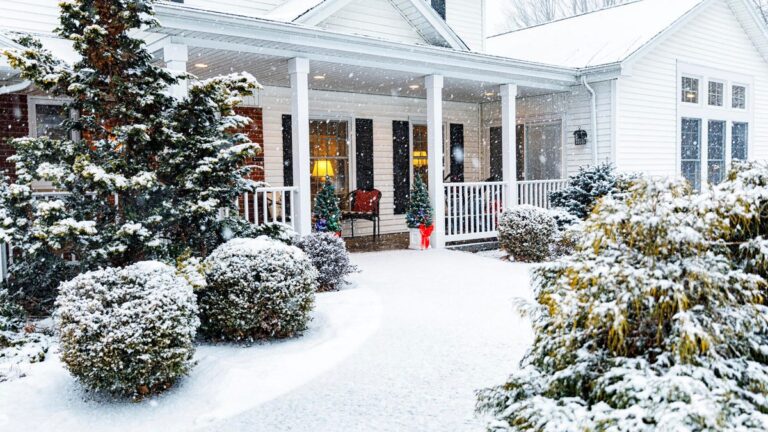Winter brings bitter temperatures, snow and ice. These truths can mean disaster for your home if you’re not prepared. Cold-weather prep should chiefly center around your home, weatherproofing windows and doors to control heating costs and keeping plumbing toasty to prevent costly repairs. When temperatures reach below 32 degrees Fahrenheit, the chances that pipes will freeze greatly increase. This can mean a minor inconvenience (living without water for a short time) or an expensive headache requiring repairs to pipes (costing $421 on average) and the parts of your home sustaining water damage.
Both scenarios are not ideal and can be avoided with these expert home maintenance tips to keep your pipes warm and cozy throughout the winter months.
Read More: Rising Energy Costs Push Inflation Up Again. Ways You Can Save This Winter
Cover exposed pipes
When your water supply pipes are exposed, they’re more susceptible to freezing and bursting, especially if they’re located along exterior walls or in unheated spaces like a basement or attic. To prevent this, it’s a good idea to protect pipes with insulation.
Covering your exposed plumbing is one of the cheapest and easiest ways to prevent burst pipes. Your local hardware store will have several materials that can be used to insulate your pipes, including foam and fiberglass insulation. You can even use newspaper to cover exposed pipes if you live where freezing temperatures only happen occasionally.
Insulate unheated areas
When plumbing runs through an unheated basement, attic, garage or crawl space, the pipes don’t get as much warmth as they would in a heated bedroom or living room. By insulating the unheated areas in your home, pipes will stay warmer and be less likely to burst. Plus, well-insulated homes contain heat more effectively, which can save you money on winter heating bills.
If you’re the DIY type, you can add insulation on your own. Otherwise, you can hire a professional to complete the task. Either way, it’s a cost-effective and energy-efficient way to protect your pipes and keep your home at a comfortable temperature.
Keep a tap running on cold days
You might be surprised to learn that something as simple as running a tap can help prevent frozen pipes. But in reality, it’s one of the most effective things you can do. You don’t need to leave your tap running at full blast, just make sure it has at least a slow drip.
For the best results, choose the faucet that’s furthest away from your water source. Doing this will force the water to run through a large portion of your plumbing system, keeping it active and less likely to freeze. Similarly, if you have any taps that are served by exposed pipes, it’s a good idea to keep them trickling as well.
Open bathroom and kitchen cabinet doors
Another small (but useful) strategy to prevent burst pipes is to open the cabinet doors under your kitchen and bathroom sinks. By doing so, the heated air from your home will circulate beneath your cabinets and warm the pipes.
It’s particularly important to open your cabinet doors if they’re located along an exterior wall of your home. As you might expect, pipes in these areas are more likely to freeze since they’re closer to the cold outdoors.
Don’t adjust your thermostat
You may be familiar with the Department of Energy’s recommendation to adjust your thermostat during the winter to save energy, but that guidance doesn’t apply during a cold snap.
Get a smart thermostat and take control of your home’s temperature and heating schedule whether you’re home or away. The Amazon Smart Thermostat is CNET’s choice for best overall smart thermostat, but you can check out all of our best smart thermostat picks to see if there’s one that better fits your needs. The Amazon Smart Thermostat can be had for $60 at Best Buy.
Details
Instead, you should keep your thermostat at a constant temperature throughout the day and night. Doing so will help your pipes stay warmer, making them less likely to freeze and burst. Plus, maintaining a steady temperature will put less stress on your furnace, which is important during periods of extreme cold.
Seal leaks and drafty areas
Patching up the drafty areas in your home is a final tip to prevent burst pipes this winter. When you have gaps or leaks between the inside and outside of your home, it’s possible for cold air to penetrate, lower the temperature around your plumbing and cause pipes to burst.
The good news: it’s easy to seal these leaks. Get started by taking a quick walk around your house to identify any places where air could sneak in, including window and door frames, electrical wiring and dryer vents. Once you’ve determined the problem areas, use insulation or caulk to seal them up.
The bottom line
Even if home maintenance isn’t your strong suit, tackling all of these repairs in a single weekend should be simple. It may seem inconvenient, but making these minor upgrades is a small commitment that can prevent serious headaches and expensive future repairs.
More in energy and utilities
Here Are 23 Ways to Save On Your Electric Bills Right Now
See all photos
Read the full article here

